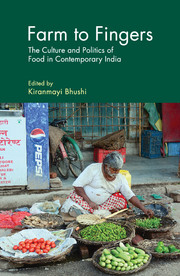Book contents
- Frontmatter
- Dedication
- Contents
- List of Figures and Tables
- Preface
- 1 Introduction
- 2 The Making of ‘Edible Animal Source Foods’ and its Contemporary Reality in Delhi
- 3 Appropriating the Cow: Beef and Identity Politics in Contemporary India
- 4 Eating Akhuni in India
- 5 Health, Standardization and ‘Bengali’ Sweets
- 6 Treating Children, Feeding Junk Food: An Inquiry into a Middle Class Project
- 7 Diaspora Dish: Cooking, Writing, and Creating Identities in Food-blogs
- 8 Measuring Hunger: Debates on an ‘Adequate’ Diet in Colonial North India
- 9 Managing Food: India's Experience with the Public Distribution System
- 10 Food Sovereignty: The Future of Food
- Contributors
- Index
4 - Eating Akhuni in India
Published online by Cambridge University Press: 05 July 2018
- Frontmatter
- Dedication
- Contents
- List of Figures and Tables
- Preface
- 1 Introduction
- 2 The Making of ‘Edible Animal Source Foods’ and its Contemporary Reality in Delhi
- 3 Appropriating the Cow: Beef and Identity Politics in Contemporary India
- 4 Eating Akhuni in India
- 5 Health, Standardization and ‘Bengali’ Sweets
- 6 Treating Children, Feeding Junk Food: An Inquiry into a Middle Class Project
- 7 Diaspora Dish: Cooking, Writing, and Creating Identities in Food-blogs
- 8 Measuring Hunger: Debates on an ‘Adequate’ Diet in Colonial North India
- 9 Managing Food: India's Experience with the Public Distribution System
- 10 Food Sovereignty: The Future of Food
- Contributors
- Index
Summary
Introduction
I received a text message on a September evening in 2014. Phrynium placentarium: family Marantaceae appeared on my screen. Earlier that morning, a conversation about fermented soya beans, popularly known as akhuni in Nagaland, abruptly came to a halt. My akhuni interlocutors, an elderly woman and a young woman both praised in the neighbourhood as excellent akhuni makers, appeared embarrassed. They were unable to pinpoint the proper name, or as they put it, the ‘English scientific name’ of the leaves with which they wrapped the akhuni cakes. The young woman expectantly turned towards the elderly woman to salvage the conversation. “I will call my cousin brother who works in the horticulture department and text it to you,” the elderly woman said. The discussion quickly resumed.
The anxiety that surfaced during our conversation as a consequence of the pursuit for a scientific name of the leaf reflects, in Saurabh Dube's words, ‘…(the) acute reflections of the hierarchies of modernity’ (2002: 731). Such moments of insecurities and the quest for scientific names are premised on creating ruptures with particular visions of the past. In the Naga people's case, it is the dominant image of primitivism, savagery, and their knowledge systems being relegated as a ‘tribal’ practice that is simple and elementary. If one roughly maps the trajectory of modernity on the register of food and dietary habits, including the promotion of a national cuisine in India via cookbooks, television shows, political manifestos, and popular magazines, it appears that there is a reiteration of a singular version of Indian modernity (Appadurai 1988). One way to understand this dominant version of Indian modernity is to note how a particular version of Indian history and power networks plays a significant role in dictating the dietary practices of dominant groups as national cuisine, while other food habits are erased from the social memory and the dining tables of the nation.
- Type
- Chapter
- Information
- Farm to FingersThe Culture and Politics of Food in Contemporary India, pp. 80 - 102Publisher: Cambridge University PressPrint publication year: 2017
- 2
- Cited by

